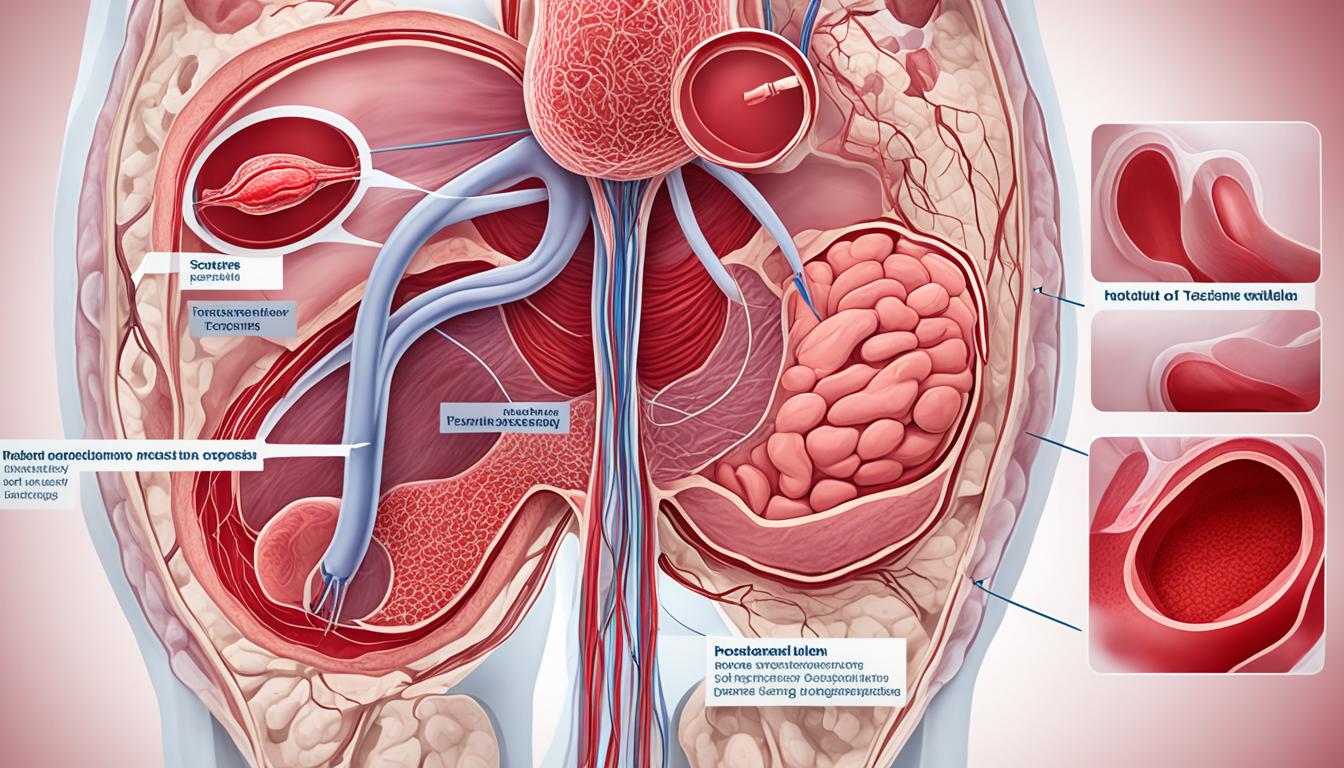Testicular torsion is a serious issue that mainly happens to kids. It’s a surgical emergency. If not treated quickly, it can cause the testicle to die and shrink. Knowing the signs and getting help fast is key to save the testicles and avoid problems later on.
The main sign of testicular torsion is a sharp, sudden pain in one testicle. You might see the testicle is higher than usual and feel a lot of pain in the scrotum. Seeing these signs means you need to act fast and get checked by a doctor.
Doctors use your reported symptoms and a physical exam to guess what’s wrong. But they might need tests, like a color Doppler ultrasound, to be sure. This test shows if the blood is flowing right to the testicle, which can help diagnose the problem.
Reacting quickly is important for the testicle’s health. Surgery is usually needed to fix a twisted cord and save the testicle. It’s best to get to the hospital within six hours of the first pain. This boosts the chances of keeping the testicle working.
Although surgery is the main fix for this problem, new treatments like stem cell therapy are being looked into. Stem cell therapy could help the testicle heal and keep making sperm. We still need more studies to know if this way of treating works well and is safe. But it might offer hope for a better recovery for people with testicular torsion.
Key Takeaways
- Testicular torsion is a serious problem often seen in children.
- Know the symptoms like sudden testicle pain, scrotal pain, and the testicle being higher than usual.
- Getting help fast is crucial to avoid the worst outcomes.
- Doctors use symptoms and tests like color Doppler ultrasound to check blood flow to the testicle.
- Getting treated within six hours is important to save the testicle, usually through surgery.
- Stem cell therapy is a new, promising way to possibly improve the recovery from testicular torsion.
Symptoms of Testicular Torsion
Testicular torsion starts with sudden and intense pain in one testicle. This pain can be really bad and shows up without warning. You might also notice that the scrotum is swollen and painful. It might look red or a different color. The testicle will seem to sit higher and could even be twisted.
Sometimes, the pain from testicular torsion goes away on its own. This makes people think they don’t need to see a doctor. But the problem is that without treatment, the testicle can die, leading to serious issues. If this happens, the testicle might get smaller or need to be removed.
If you or someone you know has very bad pain in the testicles, get help as soon as possible. Testicular torsion is a problem that often needs surgery quickly. Waiting too long could cause the testicle to be lost or damaged forever. This is why it’s so important to act fast if you feel this kind of pain.
| Symptoms of Testicular Torsion | Other Common Symptoms |
|---|---|
| Sudden and severe testicular pain | Swelling and pain in the scrotum |
| Higher position of the twisted testicle | Radiating pain |
| – | Discoloration of the scrotum |
Diagnosis of Testicular Torsion
Spotting testicular torsion early is key for the right treatment. To know for sure, doctors look at both your symptoms and do tests.
Clinical Symptoms
Severe, sudden pain in one testicle is a major sign of testicular torsion. You might have swelling and feel your scrotum is uncomfortable. The affected testicle may sit higher in the scrotum than the other one.
The pain and swelling can hit your lower belly or groin too. But, how these signs show up can vary from person to person.
Diagnostic Tests
Doctors often use a color Doppler ultrasound to confirm testicular torsion. This test shows blood flow in the testicles and nearby areas. If you have torsion, the test can show blood flow issues and other problems in the area.
This ultrasound is key because it helps tell torsion apart from other issues with similar symptoms. Those include epididymitis or a twisted testicular appendage.
| Diagnostic Method | Advantages | Limitations |
|---|---|---|
| Color Doppler Ultrasound | – Non-invasive imaging technique | – Operator-dependence |
| Clinical Examination | – Can be performed quickly | – False-negative results |
| Further Imaging (MRI, CT) | – Provides detailed anatomical information | – Availability and cost may be barriers |
Getting a fast, accurate diagnosis can save your testicle and its function. If you suspect torsion, see a doctor right away to prevent any treatment delays.
Stem Cell Therapy for Testicular Torsion
Stem cell therapy shows hope for those with testicular torsion. It uses the healing power of stem cells. This treatment aims to fix the testicles and keep fertility.
Regenerative medicine relies on the body’s healing to fix issues like testicular torsion. Stem cell therapy can help by repairing the damaged parts. It’s a promising avenue for saving future family planning.
More studies and tests are needed to be sure about stem cell therapy’s effects and safety. But, it’s a hopeful option for people dealing with testicular torsion. With ongoing discoveries, stem cell treatment could greatly improve these patients’ lives.

